|
Why
is this goal important?
A free marketplace where consumers
have the confidence they are getting a fair deal is the cornerstone of our
system of commerce and finance.
What is
DOC doing to achieve this goal?
The Department of Commerce is
primarily a regulatory agency that oversees more than 20 industries
including insurance, state chartered banks and credit unions, real estate,
energy, and telecommunications.
Minnesota consumers contact the Department when they
encounter a problem in
one of these industries. Each year, the Department receives about 70,000
consumer phone calls, conducts about 10,000 investigations, returns millions
of dollars in unclaimed property, and advocates for the public's interest
before the Public Utilities Commission.
By increasing efficiency and improving technology, consumers will experience
better service. In addition, the Department will be able to better identify
and respond to regulatory issues before consumers encounter problems. The
Department has taken several steps to accomplish these goals:
 The
Consumer Response Team resolves insurance consumer complaints, when
The
Consumer Response Team resolves insurance consumer complaints, when
possible, rather than conducting time-intensive formal investigations.
 The
Department has added resources to complete additional consumer
investigations in
The
Department has added resources to complete additional consumer
investigations in
a thorough and timely manner.
 The
Department continues to increase public awareness of Unclaimed Property
The
Department continues to increase public awareness of Unclaimed Property
program
through advertising and our presence at the Minnesota State Fair.
 The
Weights and Measures staff checks the accuracy of
all commercial weighing and
The
Weights and Measures staff checks the accuracy of
all commercial weighing and
measuring equipment in Minnesota.
What is
the department's progress on this goal to date?
Consumer Response and Insurance Investigations
The Minnesota Department of Commerce Consumer Response Team (CRT) is
comprised of investigators who respond to consumer phone calls specifically
about insurance. The CRT attempts to resolve disputes between consumers and
the insurance industry informally. An increasing percentage of consumers are
resolving their disputes informally and a large majority of formal
investigations were completed within 90 days.
In calendar year 2006, the
CRT responded to 33,737
phone calls, helping consumers with issues relating to the following
industries:
·
Real Estate: 8,178 calls
·
Insurance: 20,801 calls
·
Securities: 1,286 calls
·
Collections: 2,127 calls
·
Do Not Call: 376 calls
·
Licensing: 969 calls
Market
Assurance
If a complaint cannot be handled by the Consumer Response Team, a file is
opened with an investigator with the Market Assurance division. The
Department of Commerce investigates complaints in the following areas:
Market
Assurance Formal Investigations
|
Year |
Formal
Investigations Opened |
Formal
Investigations Closed |
Formal
Investigations Recovery |
Formal
Disciplinary Actions |
Civil Penalties |
|
2001 |
10864 |
9920 |
$7,708,730 |
651 |
$943,322 |
|
2002 |
10956 |
10326 |
$7,278,734 |
811 |
$4,266,136 |
|
2003 |
9438 |
9078 |
$9,166,666 |
614 |
$6,780,210 |
|
2004 |
9464 |
9431 |
$5,291,849 |
680 |
$1,280,071 |
|
2005 |
8039 |
9662 |
$6,794,962 |
844 |
$3,126,095 |
|
2006* |
7233 |
7368 |
$8,805,796 |
417 |
$4,966,580 |
|
*Note: Building contractors
and cosmetologists no longer regulated by the Department of Commerce |
Unclaimed Property Claims
Processed
Every day, someone loses some form of financial property because of a change
of address, death, or just plain forgetfulness. What happens to these
forgotten funds? The Unclaimed Property Division is responsible for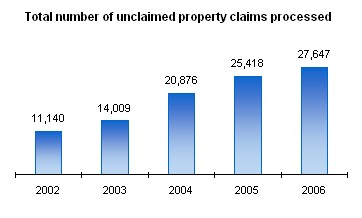 holding
the abandoned funds or property until
the rightful owner or heir claims it. As the data below suggests, we have
seen a significant increase in claims processed in the last four years. The
increase is attributable to the program receiving over 100 million dollars
in funds from life insurance companies that converted from privately-held to
publicly-held entities. The following graph shows the number of claims processed and
returned to rightful owners in each of the following calendar years. holding
the abandoned funds or property until
the rightful owner or heir claims it. As the data below suggests, we have
seen a significant increase in claims processed in the last four years. The
increase is attributable to the program receiving over 100 million dollars
in funds from life insurance companies that converted from privately-held to
publicly-held entities. The following graph shows the number of claims processed and
returned to rightful owners in each of the following calendar years.
Since its
inception in 1969, the Unclaimed
Property Program has returned approximately $200 million to rightful owners.
Weights and Measures
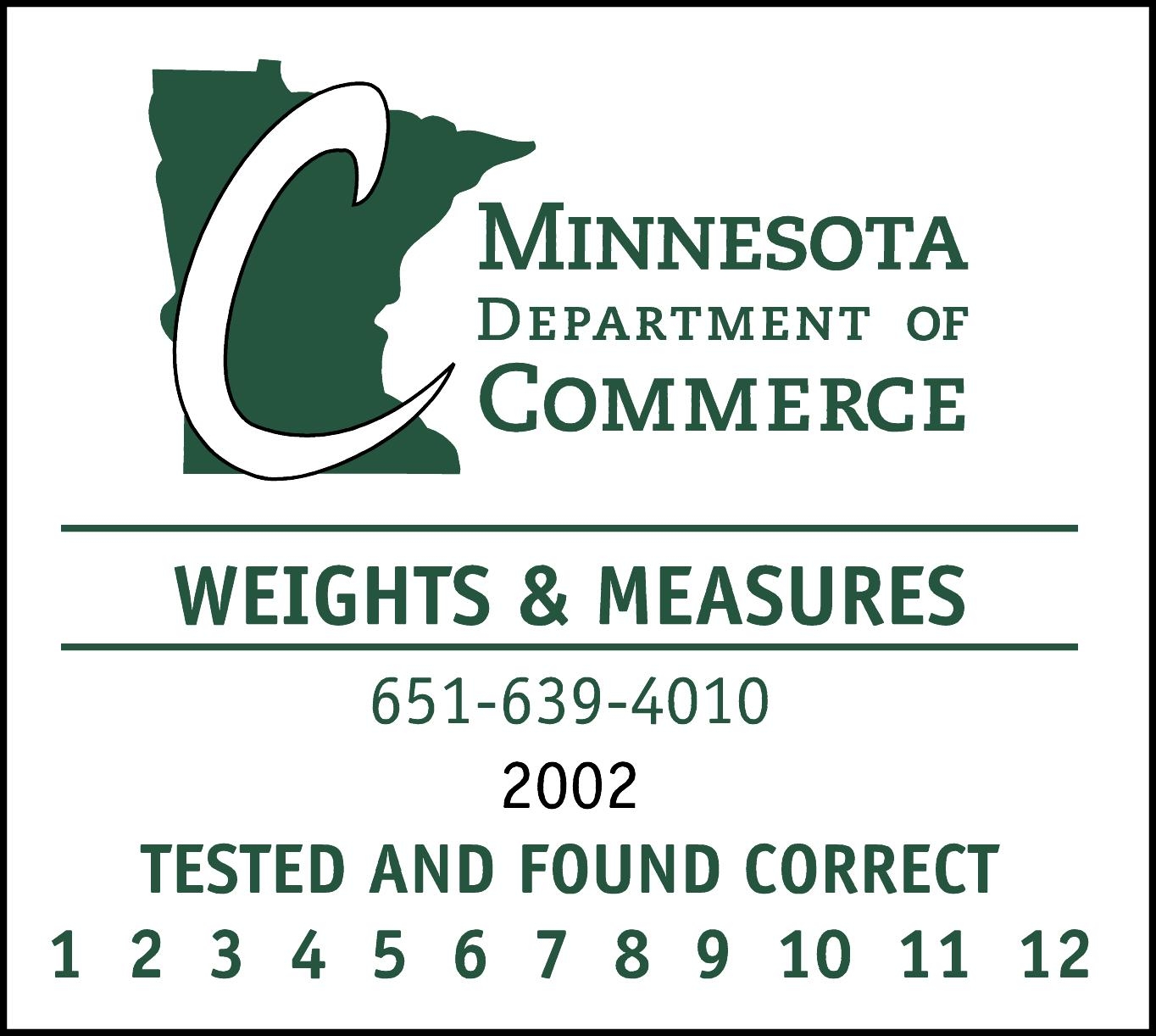 The Weights and Measures Division benefits Minnesota
buyers and sellers
in commercial transactions. The division is responsible for checking the
accuracy of all commercial weighing and measuring devices in Minnesota,
from gas pumps to grain elevators to grocery scales. The Division has 34
employees which includes 22 field staff. The Weights and Measures Division benefits Minnesota
buyers and sellers
in commercial transactions. The division is responsible for checking the
accuracy of all commercial weighing and measuring devices in Minnesota,
from gas pumps to grain elevators to grocery scales. The Division has 34
employees which includes 22 field staff.
Weights and Measures
light duty staff inspected 43,000 gas pumps in 2006 with a 96% compliance
rate. In addition, they inspected 8,200 light capacity scales, 1,100 vehicle
tank meters, 675 hi-volume meters at the terminals, refineries, ethanol
plants, and airports. Also, 270 package checking inspections were performed
at grocery stores and other food related facilities.
The heavy duty field staff inspected 2,550
large capacity scales, including scales for vehicles, livestock, and grain
and fertilizer.
The Department received 457 complaints with
37 resulting in action taken such as warnings, fines, or rejections. The
majority of the complaints pertain to petroleum pump accuracy and quality of
the product. The
metrology lab calibrated more than 1,400 artifacts, including five gallon
measures, one gram weights, and 100,000 pound railroad test cars.
Other accomplishments:
-
Moved to a new
state-of-the-art facility in Burnsville, which includes a new petroleum
and metrology lab
-
The petroleum lab
has been upgraded with new equipment to perform additional quality
testing for all types of fuels
-
The metrology lab
space has doubled in square footage
-
We will increase
the calibration services by 25% to 40% with the new electronic equipment
that has been purchased and installed
-
We implemented a
database system for below cost gas pricing (BCGP) complaints and B2 bill
of lading collections
-
We now do field
evaluations (scales) for the National Type Evaluation Program (NTEP) as
part of National Conference on Weights and Measure organization
|
Why
is this goal important?
The Department of Commerce issues approximately 280,000 licenses that are
held by individuals and companies doing business in Minnesota. Each year,
more than 40,000 licenses are renewed and about 50,000 new applications are
processed by the Department's licensing unit. Insurance companies file more
than 5,000 rate and policy forms each year.
In each of the above instances, the
Department must review, approve, and process these filings or applications.
Individuals and business must wait for the Department to complete its work
before they can proceed.
Minnesota consumers
benefit from additional choices and competition in the marketplace and
delays in processing these applications limits consumer options.
What
is DOC doing to achieve this goal?
 The Department
continues to expand on-line licensing functions including systems to
The Department
continues to expand on-line licensing functions including systems to
process new license applications, renewals, and more license types. The
Department
has moved its licensing function for insurance agents and
companies completely online;
reducing the time it takes to receive a
license from as much as twelve weeks to a matter
of days. The Department
is partnering with a private vendor to bring better and faster
service
to Minnesota's 90,000 active insurance agents and 7,612 active agencies.
 The Department
encourages electronic filing through
the System for Electronic Rate and
The Department
encourages electronic filing through
the System for Electronic Rate and
Form Filing (SERFF) operated by the National Association of Insurance
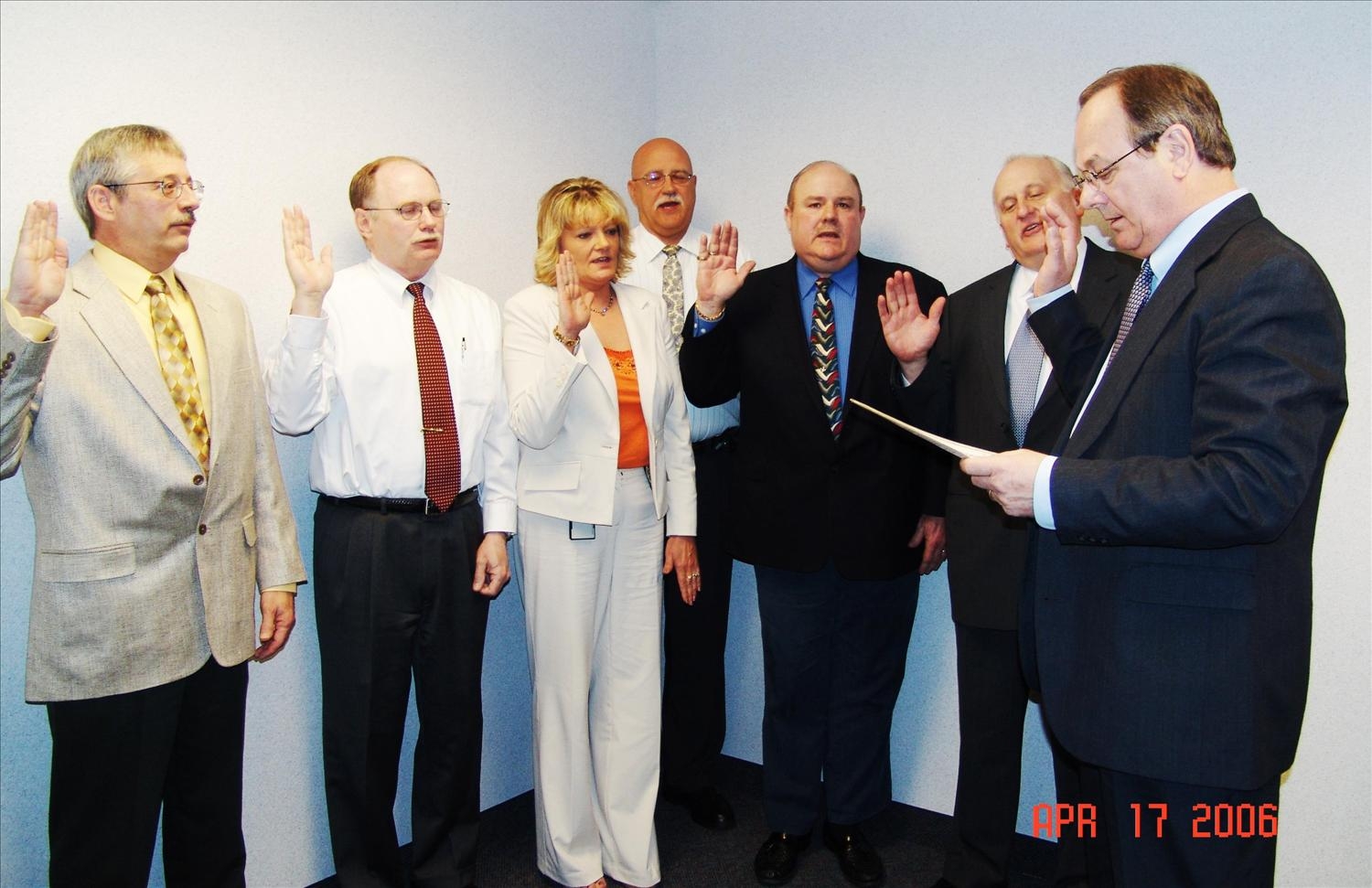
Commissioners.
 The Division of
Insurance Fraud
The Division of
Insurance Fraud
Prevention
conducts
investigations and
makes arrests in
cases of insurance
fraud alleged by insurance companies,
other law
enforcement agencies, or
consumers.
 The Financial
Exams Division seeks to
The Financial
Exams Division seeks to
maintain the Department's accreditation
with
both the Conference of State Bank
Supervisors and the National
Association of Insurance Commissioners.
Fraud Unit being sworn in
|
|
What is
the department's progress on this goal to date?
Online
Licensing
The increase of electronic rate and form filing is decreasing the amount of
time to process rate and form filings. The insurance licensing tool was launched on
May 24, 2006 and in its first three weeks of operation, 950 insurance agents and
companies had already completed online applications. In
October of 2006, over 45,000 insurance producers renewed their license using
the new online system. The remaining 45,000 insurance producers will renew
online beginning in October of 2007.
Real
Estate licensing is also occurring completely online for the first time in
the summer of 2007.
Insurance Filings Using SERFF and
Number
of Days to Process Filings
When an insurance company develops a new policy or product, generally
speaking, that policy must be approved by the Department before it can be sold to consumers. The Department has used the System for Electronic Rate
and Form Filing to speed this approval process, creating more choices for
consumers in the insurance marketplace.
Effective
January 1, 2008, this process will be completely electronic as the SERFF
system will be mandated for all insurance filings.
|
Year |
Total Filings |
Using SERFF |
Percentage |
|
2002 |
6,428 |
333 |
5 |
|
2003 |
6,486 |
979 |
14 |
|
2004 |
5,859 |
1,880 |
32 |
|
2005 |
5,672 |
2,526 |
44 |
|
2006 |
5,182 |
2,728 |
53 |
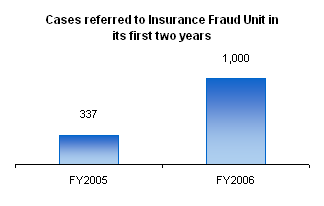
Fraud
Prevention
The
Department is on schedule to handle more than 1,000 referrals in Fiscal Year
2007 with several high profile cases handed over for prosecution to
state
and federal law enforcement agencies.
Keeping Financial Institutions Sound
The Financial Exams Division was recently awarded another five year
accreditation with the National Association of Insurance Commissioners. The
Department also maintains accreditation with the Conference of State Bank
Supervisors.
Both of
these entities perform a periodic peer review/quality control assessment to
assure that our examination and oversight with respect to banks and insurers
is sufficiently rigorous.
The best
measure of success in this area is the lack of financial institution
failures in Minnesota during the last five years.
|
|
Why is
this goal important?
Expanding the
availability and use of clean alternative fuels will reduce pollution, add
money to the Minnesota economy, and lessen our dependence on other states
and nations for energy supplies. Experts estimate that by 2050, most of the
economically recoverable petroleum in the world will be exhausted and long
before then, the price of petroleum will rise as the production declines.
For these reasons, Minnesota state energy policy promotes the use of clean
fuels on our streets and highways by working with the federal government,
non-profit organizations, and private industry to help develop viable
alternatives to gasoline and diesel fuels.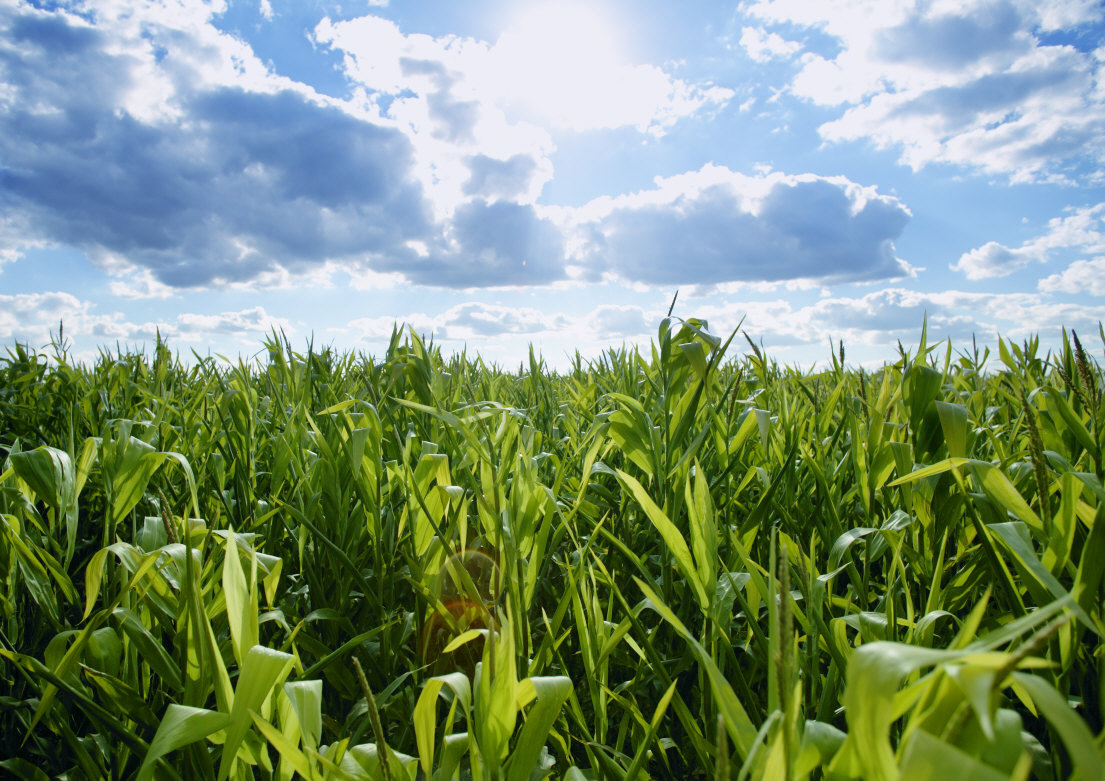
Clean fuels have two
main characteristics: in most cases their primary content is a substance
other than petroleum and they emit lower levels of pollution than gasoline
or diesel.
Because alternative
fuels are most commonly produced from corn and waste products, they have
significant economic benefits for Minnesota, an agricultural state without
petroleum reserves.
Predicting the future of
alternative fuels is difficult, but the economic and environmental problems
associated with our present reliance on gasoline and diesel fuel bode
strongly for changes in transportation energy use. Gasoline and diesel
account for about 40 percent of our state’s total energy use with nearly
one-third of what we spend for energy going to buy gasoline and diesel fuel.
For the nation, two-thirds of all oil used in the United States goes for
transportation; in Minnesota, the percentage is even higher - about three
quarters.
This reliance on gas
and diesel results in dependence on foreign oil and accounts for more than
40 percent of our nation’s growing world trade deficit. In addition to these
economic problems, gasoline and diesel also harm the environment. The air in
many U.S. cities contains unacceptable amounts of carbon monoxide,
hydrocarbons, and other pollutants harmful to human health. A large portion
of these emissions comes from motor vehicles.
What is DOC doing to achieve
this goal?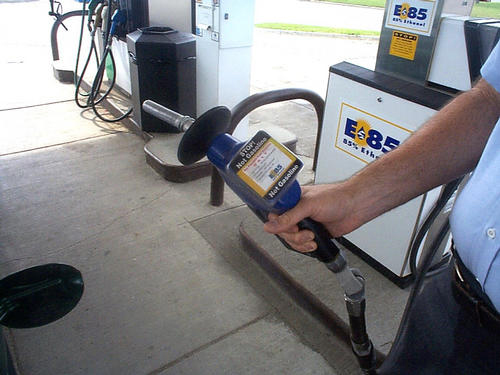
The use of E85 continues to be the most available and promising alternative
fuel source in the state. E85 is composed of 85 percent ethanol and 15
percent gasoline, emits fewer pollutants and has higher octane than
gasoline. It performs very much like gasoline, although the fuel has a lower
energy content than gasoline.
E85 is an alternative
fuel, not to be confused with traditional Minnesota gasoline that has about
10 percent ethanol added as an oxygenate to reduce pollution. E85 is also
different than “low-sulfur gasoline” that also reduces pollution from
conventional gasoline (and also contains 10 percent ethanol).
A distinct advantage of
E85 as an alternative fuel is the ready availability of flexible fuel
vehicles (FFVs), which run on E85, gasoline, or any combination of the two.
A current list of FFVs can be found on the Department of Commerce web site.
Since 1995, the Minnesota Department of Commerce has worked with other state
agencies, the federal government, private industry, public interest groups,
and others to encourage the development, testing, and use of alternatives to
petroleum fuels so that they can eventually enter the marketplace and
compete with conventional transportation fuels.
The Department offers
grants to petroleum retailers to offset the cost of converting tanks to
handle E85 or install new tanks specifically for E85.
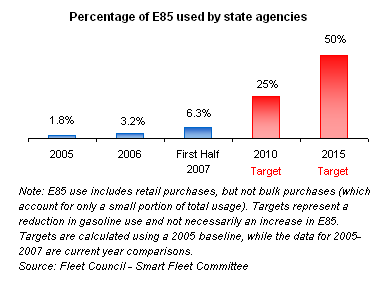
In September 2004,
Governor Pawlenty signed an executive order requiring state agencies to
reduce gasoline use in on-road vehicles 25% by 2010 and 50% by 2015, and to
reduce petroleum-based diesel fuel use 10% by 2010
and 25% by 2015. At least 75% of most new onroad vehicles must be powered by
biodiesel (blends of 20% or greater), ethanol (blends of 70% or greater), or
hydrogen. Vehicles with high fuel economies - such as hybrid vehicles - also
qualify under Minnesota’s executive order.
Governor Pawlenty
reinforced this commitment to renewable fuels by issuing another executive
order in March of 2006 directing all state departments to immediately take
all reasonable actions necessary to strengthen the infrastructure for
increasing the availability and usage of E85 and biodiesel fuel throughout
the state.
What is the department's progress
on this goal to date?
Since 1995, when the Minnesota Department of
Commerce began promoting clean fuels through private-public partnerships,
use of E85 has grown substantially in Minnesota. Approximately 150,000
flexible fuel vehicles were registered in the state as of early 2007,
according to the American Lung Association of The Upper M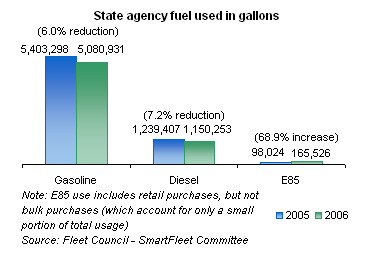 idwest. Minnesota
leads the nation in developing E85 fueling sites, with plans to double the
number of stations over the next few years from 300 to approximately 600.
This represents nearly half the E85 stations in the United States and
Minnesota is seen as a model for building a competitive choice to gasoline. idwest. Minnesota
leads the nation in developing E85 fueling sites, with plans to double the
number of stations over the next few years from 300 to approximately 600.
This represents nearly half the E85 stations in the United States and
Minnesota is seen as a model for building a competitive choice to gasoline.
The
use of E85 in the
state fleet has also increased since the Governor’s executive orders of 2004
and 2006. E85 use by state agencies increased 69%, growing from 98,000
gallons in 2005 to over 165,000 gallons in 2006.
|
|
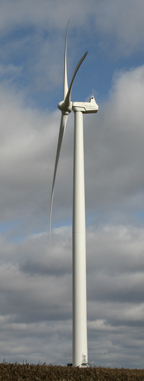 Why is this goal important? Why is this goal important?
Wind is the best opportunity we have in
Minnesota to produce our own renewable energy. Minnesota is not blessed with
coal reserves or underground oil fields, but we do have wind. The production
of wind energy also causes no negative environmental impacts. Once a turbine
is constructed, it does not use fuel, water or any other form of energy to
work.
As the wind industry
matures, advances in technology are making this form of energy increasingly
reliable and Minnesota utilities are improving their ability to integrate
wind energy into the state’s supply grid.
Community-Based Energy
Development (C-BED) is a critical and unique component of Minnesota’s
Renewable Energy Objective. C-BED projects are locally-owned wind energy
projects located in Minnesota. As with the farmer-owned ethanol plants that
have acted as economic anchors for Minnesota’s farm communities and rural
economies, C-BED projects capture energy dollars to the local economy to be
reinvested locally again and again. Local ownership and local benefits of
energy production is central to the Pawlenty Administration’s energy policy.
What is DOC doing to
achieve this goal?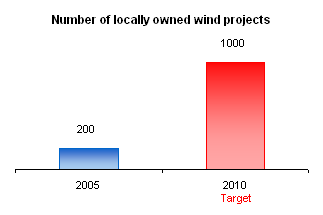
Minnesota is the unquestioned national leader on local ownership of wind
energy production. In November of 2005, Governor Pawlenty sought to
aggressively build on that leadership by establishing a C-BED goal for the
state of an additional 800
megawatts (MW) of locally owned wind projects by 2010 (on top of the
nation-leading 200 MW in operation in 2005).
The Minnesota
Department of Commerce is working with our state’s utilities to increase the
number and quality of their community based
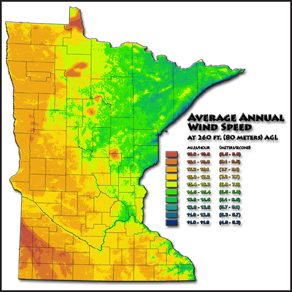 wind projects. The Department is
also working with wind developers to make sure their projects are cost
effective, reliable and ultimately a good deal for Minnesota ratepayers. wind projects. The Department is
also working with wind developers to make sure their projects are cost
effective, reliable and ultimately a good deal for Minnesota ratepayers.
A key component to the
C-BED statute is the availability of a "front-end loaded rate" for the
energy from a community-based energy project. The front-end loaded rate
means that the project can receive a higher rate from the utility in the
early years of a wind energy contract, in exchange for a lower rate in the
later years of a contract. This financing tool is intended to allow C-BED
projects to overcome financing barriers, and cash flow a project during the
first 10 years of production when the project owners must service the debt
on the project.
What is the
department's progress on this goal to date?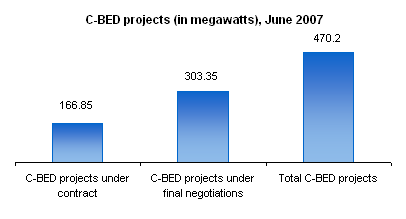
As of June 2007, over 470 MW of C-BED projects
toward meeting the Governor’s goal are either under contract (166.85 MW) or
under serious negotiation (303.35 MW). Xcel Energy has committed to
providing 500 MW toward the Governor’s C-BED goal, and accounts for over
half of the 470 MW under contract or under serious negotiation.
Utility C-BED
Rankings, June 2007
|
Utility
|
C-BED
Projects Under Contract |
C-BED
Projects Under Final Negotiations |
Total C-BED
Projects |
|
Xcel
Energy |
156.85 MW |
101.70 MW |
258.55 MW |
|
CMMPA
|
10 MW |
0.00 MW |
10.00 MW |
|
GRE
|
0 MW |
120.00 MW |
120.00 MW |
|
SMMPA
|
0 MW |
31.65 MW |
31.65 MW |
|
Minnesota
Power |
0 MW |
30.00 MW |
30.00 MW |
|
MRES
|
0 MW |
20.00 MW |
20.00 MW |
|
Total
|
166.85 MW |
303.35 MW |
470.20 MW |
|



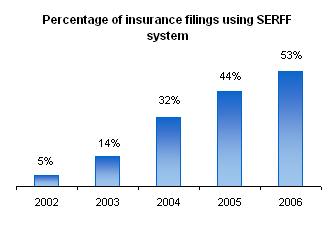
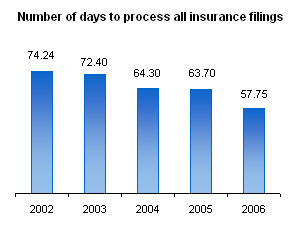




 idwest. Minnesota
leads the nation in developing E85 fueling sites, with plans to double the
number of stations over the next few years from 300 to approximately 600.
This represents nearly half the E85 stations in the United States and
Minnesota is seen as a model for building a competitive choice to gasoline.
idwest. Minnesota
leads the nation in developing E85 fueling sites, with plans to double the
number of stations over the next few years from 300 to approximately 600.
This represents nearly half the E85 stations in the United States and
Minnesota is seen as a model for building a competitive choice to gasoline.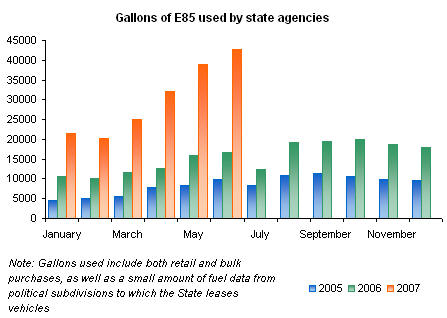
 Why is this goal important?
Why is this goal important?
 wind projects. The Department is
also working with wind developers to make sure their projects are cost
effective, reliable and ultimately a good deal for Minnesota ratepayers.
wind projects. The Department is
also working with wind developers to make sure their projects are cost
effective, reliable and ultimately a good deal for Minnesota ratepayers.